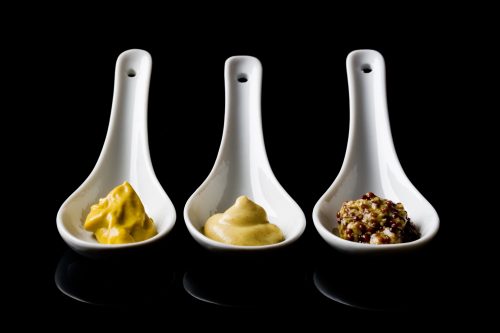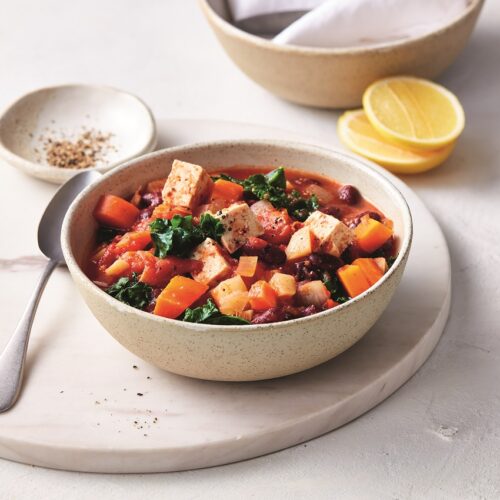
We delve into the pantry and give you the lowdown on a common condiment.
Know your mustard
Three plants from the Brassica (cabbage) family produce mustard seeds:
- White (or yellow) mustard seeds are the largest seeds and mildest in flavour
- Brown mustard seeds are a smaller seed but more pungent than white
- Black mustard seeds are the most pungent of the three
White or brown seeds are used for most commercial mustards and are found in pickling spices, while black mustard seeds are commonly used in Indian cooking.
Putting the heat into mustard
The heat from mustard seeds is produced by sulphur compounds – sinalbin in white mustards seeds and sinigrin in black – coming into contact with an enzyme in the seed, and water. When the seeds are ground and mixed with water, the chemical reaction between the sulphur compound and the enzyme produces an oil with the familiar sharp, hot flavour.
Mustard seed and wasabi contain the same compound – it's from a class of phytochemicals called isothiocyanates – that helps produce their distinct flavours. While we don't know a lot about the specific properties of mustard seed, we do know that a range of phytochemicals in our diets is a good thing. And using herbs and spices is a good way to add interest and flavour to our foods, rather than just adding salt.
Storage
Like all herbs and spices, mustard prefers to be stored in a cool, dark, airtight environment to best preserve its flavour. Generally, ground seeds or powdered mustard can be expected to keep well for six months and unopened prepared mustard could be kept for up to a year. Once opened, store prepared mustard in the fridge.
Using mustard
English, Dijon or whole grain mustards are great with ham and other meats in a sandwich; as an accompaniment to barbecue meats; added to a vinaigrette; or added to your favourite potato salad dressing.
Make 'Dijonnaise' by blending Dijon mustard with light mayonnaise.
Use your favourite mustard to add flavour to sauces, dressings and casseroles. Start with a little and taste as you go: it's easy to add more, but you can't take it out.
If a casserole recipe specifies prepared mustard, you can substitute with mustard powder at the rate 1 teaspoon mustard powder for 1 tablespoon prepared mustard. Make sure you add the powder to cold water and let the flavour develop first.
In Indian cooking, whole black mustard seeds are fried (traditionally in ghee but we recommend dry-frying) until the seeds pop. Although black mustard seeds are very hot if ground with cold water, this method produces a milder nutty flavour. The seeds can be used as a garnish or seasoning. Try sprinkling on salads, grilled fish or meat dishes.
Types of mustard
English mustard
You may think of traditional English fare as rather bland and boring. If so, their creamy mustard will surprise you. This is how the English add heat to their cuisine. Mustard seeds are mixed with vinegar, salt and spices to produce this creamy, hot and spicy taste sensation.
One to try: Delmaine Hot English mustard
Dijon mustard
Named after the town of Dijon in France, this creamy mustard is made using ground mustard seeds mixed with verjuice (unripe grape juice) or wine vinegar, which produces a milder mustard than its English cousin. Spices and herbs are added to produce its classic tangy flavour.
One to try: Maille Dijon mustard
Whole grain mustard
This has a milder mustard flavour as the seeds have not been ground so the familiar strong mustard kick is not present. The seeds are generally mixed with wine vinegar and spices to produce a spicy dressing with a nice seedy texture.
One to try: Maille Whole grain mustard
Powdered mustard
This is made from ground white and brown mustard seeds. The dry powder doesn't have much kick, but when you mix it with cold water the chemical reaction starts and the flavour develops. Wait 10-15 minutes before mixing with other ingredients.
One to try: Colman's mustard powder
American mustard
This is the one you see smothering those American hot dogs. Actually it's not hot at all, as American mustard is quite mild; it's made from white mustard seeds with sugar added. Turmeric is used to produce the bright yellow colour.
One to try: Masterfoods American mustard
Did you know?
- The phrase 'as keen as mustard' originates from a popular brand of prepared mustard in the 1700s, Keen & Sons of London.
- Jeremiah Colman first developed his mustard powder in 1804.
- Canada is now the world's largest producer of mustard seed.
- When King Darius of Persia sent Alexander the Great a bag ofsesame seeds symbolising the number of his troops, Alexander respondedby sending mustard seeds, symbolising a more potent and fiery army.
- In the courts of Medieval Europe a 'mustardarius' was the official employed to supervise the growing and preparation of mustard.
www.healthyfood.com










